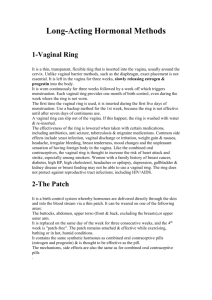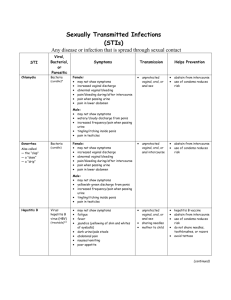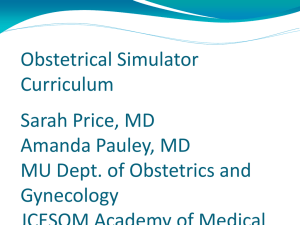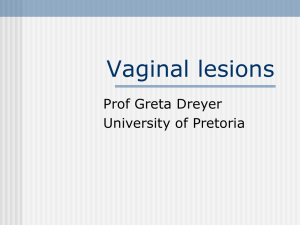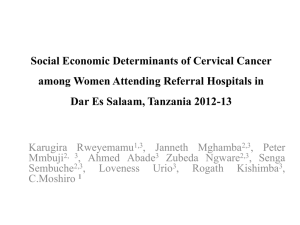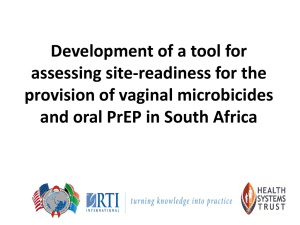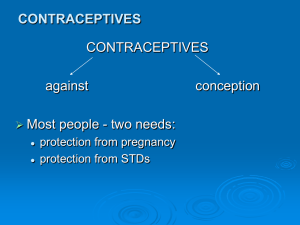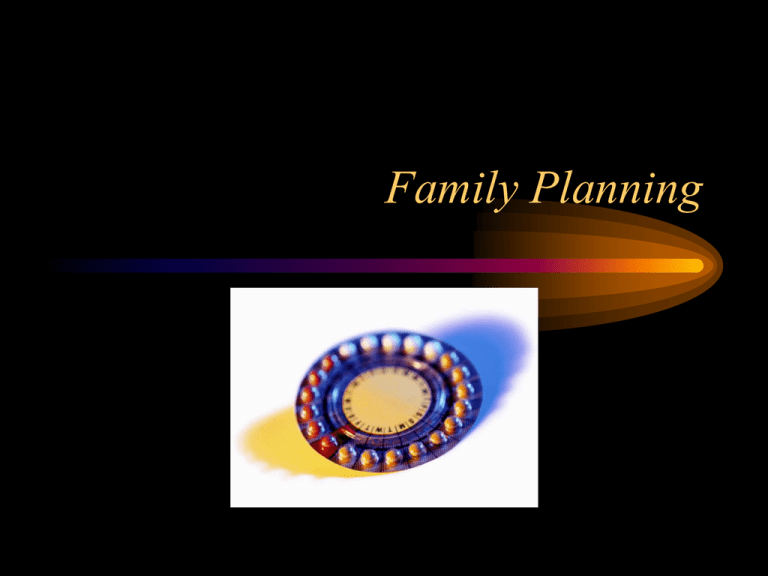
Family Planning
Contraceptives
• Nursing plays a primary role in providing
education about contraceptive choices and
teaching about the use of different methods
Contraceptives
• Educate about “safe sex” practices
• Be sure to F/U in 1 – 3 weeks on the
effectiveness of the method chosen
The Ideal Method Should Be
•
•
•
•
•
•
•
Safe
100% effective
Free of SE
Easily obtainable
Affordable
Acceptable to the user & sexual partner
Free of effects on future pregnancies
Abstinence
• Compliance
• 0 % failure rate
• Most effective way to prevent STD
Oral Contraceptives
“The Pill”
• Prevents ovulation; mimics the hormonal
state of pregnancy
– Increased estrogen--- Diminishes hypothalamic
effect on GrHR--- Inhibits the release of FSH /
LH------NO OVULATION OCCURS
– Progestin
• Affects cervical mucus & endometrial lining
Oral Contraceptives
“The Pill”
• Monophasic
– Provides fixed doses of both estrogen and
progestin throughout the 21 day cycle
• Triphasic
– Vary both estrogen / progestin throughout the
cycle
– Mimics woman’s natural hormonal pattern
Oral Contraceptives
“The Pill”
• Side effects & contraindications
– P. 107 Pillitteria
– Absolute
– Possible
• “ACHES” – Should call health care
provider immediately
Oral Contraceptives
Client Education
•
•
•
•
•
A= Abdominal pain
C= Chest pain
H= Headache (severe)
E= Eye problems (loss or blurring)
S= Severe leg pain (calf or thigh)
Oral Contraceptives
Client Education
• Missed pills
• Drugs (barbiturates, griseofulvin,
isoniazide, penicillin, tetracycline decreases
the effectiveness of the pill
• Avoid if BF’ing until milk supply is well
established
• Discontinue if pregnancy occurs
Oral Contraceptives
Client Education
• Adolescent girls should have well
established menstrual periods (2 years) prior
to starting the pill
• When to start pills
– 1st Sunday after beginning period; after
childbirth Sunday 2 weeks post delivery; post
Ab – 1st Sunday after procedure
Emergency Contraception
•
•
•
•
“morning after pill”
75% effectiveness rate
Combination estrogen/progestin
Progestin only
– < NV
– 89% effective
Emergency Contraception
• Can be taken immediately and up to 72 hrs
• Taken 2 doses; 2nd dose taken 12 hrs first
• Major SE – Nausea
– Call health care provider if severe – may prescribe
antiemetics
• Next period should begin within 2 – 3 weeks
• START IMMEDIATELY WITH AN
ACCEPTABLE METHOD OF BIRTHCONTROL
Norplant Implants
• Long acting hormonal method
• 6 silastic membrane capsules filled with
35 mg progestin
Inserted upper arm
Last for 5 years
Norplant Implants
• Effective within 24 hours after insertion
• Mode of action: suppress ovulation, thicken
cervical mucus, creates a thin atrophic
endometrium, causes more rapid tubal
transport of ovum
Norplant Implants
• Does not suppress lactation
• Side Effects
–
–
–
–
–
Menstrual irregularities
Amenorrhea after a few months
Abdominal pain
H/A
Hair growth / hair loss
Norplant Implants
• Contraindications
–
–
–
–
–
Liver Dz
Pregnancy
Unexplained vaginal bleeding
Breast CA
Hx thrombophlebitis
Depo- Provera (DMPA)
• Medroxyprogesterone Acetate
• Injectable progestin
• Mode of action: prevents ovulation,
thickens cervical mucus
Depo- Provera (DMPA)
• Dose 150 mg single dose vial
• IM – Do Not massage (hastens absorption
and shortens the period of effectiveness
• Given with 5 days of onset of period
• Within 5 days from delivery
Depo- Provera (DMPA)
• Contraception begins immediately and last
for 3 months
• Instruct client to F/U for injection 2 weeks
before 3 months is up
• Usually will not have period after 1 year of
use
Depo- Provera (DMPA)
• Side effects and contraindications same as
Norplant
• 99.7 percent effective
• ***May be used during lactation
• Women who plan to get pregnant within 6 –
9 months suggest another method
Intrauterine Device
• Progestasert & Paragard 380A
• Device inserted into uterus
• Mode of action
– Inhibits migration of sperm
– Speeds ovum transport
– Local inflammatory response in uterine cavityendotoxins are releases that destroys sperm
– Cervical mucus
Intrauterine Device
• Side Effects
–
–
–
–
–
Increased Bleeding (anemia)
Dysmenorrhea
Pelvic Infections
Ectopic Pregnancy
Uterine perforation
Intrauterine Device
• Contraindications
–
–
–
–
–
–
–
Multiple sexual partners (risk for STD’s)
Active, recent, or chronic pelvic infection
Postpartum endometritis or septic abortion
Pregnancy
Endometrial or cervical malignancy
Valvular heart disease
Immunosuppression
Intrauterine Device – Client
Education
• Palpating string – check before intercourse
and after each period
• Inspect pads and tampons for an expelled
IUD
• Advise alternate contraception 1st month
after insertion
Intrauterine Device – Client
Education
• Teach PAINS
• P – period late, abnormal spotting or
bleeding
• A – abdominal pain, pain with intercourse
• I – infection exposure, abnormal vaginal
discharge
• N – not feeling well, fever, chills
• S – string missing, shorter or longer
Intrauterine Device – Client
Education
• Advise to wait 3 months after removal
before becoming pregnant – this reduces the
risk of ectopic pregnancy
• Annual F/U
Diaphragm
• Mechanical Barrier to entry of sperm into
the cervix
• Used with a spermicide cream or jelly
provides additional protection
Diaphragm
• Safe
• Flexibility according to frequency of
intercourse
• Used with spermicide protects against STD
Diaphragm
• Complications
– Toxic Shock Syndrome
– Pg 1442 – 1443 Pillitteri
Diaphragm
• Contraindications
–
–
–
–
Hx of TSS
Allergy to latex or spermicide
Recurrent UTI
Inability to learn insertion technique (mentally
or physically challenged)
– Abnormalities of vaginal anatomy that prevents
a good fit or stable placement – uterine
prolapse, extreme retroversion
Diaphragm – Client Education
• S/S TSS
• Annual visits
• Needs to be refitted after significant weight
gain > 10 lbs, pelvic surgery, full term
delivery (after pregnancy should wait about
12 weeks PP before using the diaphragm)
Diaphragm – Client Education
• May be left in place up to 12 – 24 hrs
• Must be left in place 6 hrs after intercourse
• May be inserted up to 2 hrs before
intercourse
• Must be fitted by MD or NP
Cervical Cap
• Barrier method; soft rubber dome with a
flexible rim
• Shaped like a thimble
• Filled with spermicide
• Inserted prior to intercourse & should be
left in place at least 8 hours
• Should not be worn longer than 24 hours
Cervical Cap
• Complications
– Cervical trauma
• Client should have F/U 3 months then
annually
• Contraindications – p. 114
Cervical Cap – Client Education
•
•
•
•
•
•
•
Practice insertion & removal
Cap should not be worn during periods
Cleaning – mild soap & water
Check for tears
Do not use petroleum products
Schedule RTC 3 months
Should be refitted after delivery, gyn surgery,
significant weight gain / loss
Male Condom
• Covers penis acts as a mechanical barrier to
prevent sperm from entering the vagina
• Protects against STD’s
• Inexpensive & available without a
prescription
Male Condom
• Contraindications
– Allergy to latex or collagenous tissue
– Inability to maintain erections
– Inability to use properly
Male Condom – Client Education
• Application and removal – put on before
vaginal penetration; leave space in tip
• Should not be lubricated with petroleum
• Store in cool dry place (not wallet)
• To maximize protection against STD’s use
with spermicide
Female Condom
•
•
•
•
Vaginal Pouch
Flexible ring that fits over cervix
Provides some protection against STD’s
May be inserted up to 8 hours before
intercourse
• Expensive
• One time use
Vaginal Spermicides
• Creates a physical barrier and also kills
sperm secondary to a chemical action
• Safe & Simple
• Preps include: jellies, creams, foam,
suppositories, tablets, thin square film
Vaginal Spermicides
• Inserted into the vagina about 5 – 10
minutes before intercourse; usually are
effective for 2 hours
• Tablets and suppositories take longer to
dissolve – insert 10 – 30 minutes prior to
intercourse
Vaginal Spermicides
• Available without a prescription
• Protects against STD’s
Vaginal Spermicides
• Contraindications
– Allergy to spermicidal
– Inability to use consistently at the time of
intercourse
– Physical / mental delays
– Cervicitis
Vaginal Spermicides – Client
Education
• Consistent use
• Times of insertion
• Good contraceptive to use during the
immediate PP period
• Need to add more if intercourse is repeated
Breast Feeding
• Prolongs anovulation for a certain period of
time, but is not always effective and
ovulation may return before menstruation
reoccurs and PREGNANCY may result
• Not an absolutely reliable method
Fertility Awareness Methods
• Rely on ovulation prediction by the couple
• Important points
– Ovulation occurs 14 days before the beginning
of the next menses
– Ovum can be fertilized for 24 hours; sperm are
viable for 72 hrs
– Regular cycles can vary by +/- 2 days
Fertility Awareness Methods
• Important points
– Period of abstinence must be at least 8 days due
to variability of menstrual cycles
– *Risk of fertility is often 15 or more days, or
about half the cycle
Fertility Awareness Methods
•
•
•
•
•
Calendar Method
Basal Body Temperature Method
Cervical Mucus
Symptothermal Method
Ovulation Predictor Test
Withdrawal – Coitus Interruptus
• Male ejaculates outside vagina
• Sperm are contained in pre-ejaculatory
fluids
• Interfere with sexual satisfaction of both
partners
• **LEAST reliable method of contraception

